-

新人教版高中英语必修2Unit 4 History and Traditions-Discovering Useful Structure教案二
This teaching period mainly deals with grammar: The past participle is used as attributive and objective complement.1. Guide students to review the basic usages of the past participle used as attributive and objective complement.2. Lead students to learn to use some special cases concerning the past participle used as attributive and objective complement flexibly.3. Strengthen students’ great interest in grammar learning.1. Help students to appreciate the function of the past participle used as attributive and objective complement.2. Instruct students to write essays using the past participle used as attributive and objective complement.Step1:温故而知新。Analyze the underlined phrases and then sum up the common usages of the past participles.1.(教材P41)They had castles built(build) all around England, and made changes to the legal system.2.(教材P42)They use the same flag, known(know) as the Union Jack,...3.(教材P42)Judy and I had our car parked(park) in an underground car park near Trafalgar Square, where we could get our car battery charged(charge).Common points: f the past participle used as attributive and objective complement.Step 2:过去分词作定语时的意义1.及物动词的过去分词作定语,在语态上表示被动;在时间上,常表示动作已经发生或完成,有时也不表示时间性。Our teacher watched us doing the experiment and gave us a satisfied smile at last.我们的老师看着我们做实验,最后给了我们一个满意的微笑。The plan put forward at the meeting will be carried out soon.会上提出的计划将很快被执行。2.不及物动词的过去分词作定语,它不表示被动意义,只强调动作完成。Many little kids like gathering fallen leaves in the yard.

新人教版高中英语必修2Unit 4 History and Traditions-Reading and Thinking教案一
Features of languages1.Finally, in the 20th century, the southern part of Ireland broke away from the UK, which resulted in the full name we have today: the United Kingdom of Great Britain and Northern Ireland.该句是一个复合句。该句主句为:the southern part of Ireland broke away from the UK;which resulted in the full name we have today为which引导的定语从句代指前面整句话的内容,we have today为定语从句修饰先行词name。译文:最后,在20世纪,爱尔兰南部脱离英国,这导致了我们今天有的英国的全名:大不列颠及北爱尔兰联合王国。2.Almost everywhere you go in the UK, you will be surrounded by evidence of four different groups of people who took over at different times throughout history.该句是一个复合句。该句主句为:you will be surrounded by evidence of four different groups of people;其中Almost everywhere you go in the UK为让步状语从句; who took over at different times throughout history为定语从句修饰先行词people。译文:几乎无论你走到英国的任何地方,你都会发现历史上有四种不同的人在不同的时期统治过英国。3.The capital city London is a great place to start, as it is an ancient port city that has a history dating all the way back to Roman times.该句是一个复合句。该句主句为:The capital city London is a great place to start; as it is an ancient port city that has a history dating all the way back to Roman times.为原因状语从句;dating all the way back to Roman times为现在分词短语作定语修饰history。

新人教版高中英语必修2Unit 4 History and traditions教案
这个地区有着深厚的传统。既学既练:为了让更多的外国游客了解中国文化,欣赏中国美丽的自然风光,感受中国发生的巨大变化,某外文杂志社将出版一本英语小册子来介绍中国的旅游景点。该杂志社邀请你为该小册子写一篇英语短文来介绍杭州,内容包括:1.杭州的位置(中国东南部)、面积(16 000多平方公里)及历史(2 200多年)等;2.杭州的旅游特色(自然风景、传统文化、特色小吃等);3.希望更多的游客来杭州参观。注意:1.词数80左右;2.可适当增加细节,以使行文连贯。Located in the southeast of China, Hangzhou is a beautiful city.Dating back more than 2,200 years, Hangzhou covers an area of more than 16,000 square kilometers.In Hangzhou, you can visit the West Lake, whose scenery is fascinating.In addition, you can’t miss its cultural relics and historical sites, from which you will learn more about excellent Chinese traditional culture and traditions.In Hangzhou, the special snacks are famous and visitors from different parts of the world think highly of them.As a tourist attraction, Hangzhou attracts a large number of visitors from home and abroad every year.Once you come to China, Hangzhou is a scenic spot you can’t miss.

新人教版高中英语必修2Unit 5 Music-Discovering Useful Structures教案一
Step1:自主探究。1.(教材P52)Born(bear) in the USA on 2 January 1970, Whitacre began studying music at the University of Nevada in 1988.2.(教材P52) Moved(move) by this music, he said, “It was like seeing color for the first time.”3.(教材P56)I was very afraid and I felt so alone and discouraged(discourage).4.(教材P58)Encouraged(encourage) by this first performance and the positive reaction of the audience, I have continued to play the piano and enjoy it more every day.Step2:语法要点精析。用法1:过去分词作表语1).过去分词可放在连系动词be, get, feel, remain, seem, look, become等之后作表语,表示主语所处的状态Tom was astonished to see a snake moving across the floor.汤姆很惊讶地看到一条蛇正爬过地板。Finally the baby felt tired of playing with those toys.终于婴儿厌倦了玩那些玩具。注意:1).过去分词作表语时与被动语态的区别过去分词作表语时,强调主语所处的状态;而动词的被动语态表示主语是动作的承受者,强调动作。The library is now closed.(状态)图书馆现在关闭了。The cup was broken by my little sister yesterday.(动作)昨天我妹妹把杯子打碎了。2)感觉类及物动词的现在分词与过去分词作表语的区别过去分词作表语多表示人自身的感受或事物自身的状态,常译作“感到……的”;现在分词多表示事物具有的特性,常译作“令人……的”。

新人教版高中英语必修2Unit 5 Music-Reading and Thinking教案二
1. Get basic information about Eric; read deeply to understand the history and development of the virtual choir.2. Understand what the function of the virtual choir is and how to make a virtual choir.3. Understand the meaning of some languages in the context of the text through question guidance, such as “Many people do not have close friends or contacts who have the same interest in music.” and so on.Step 1 Leading-in1. Answer the following questions.Q1:Do you know the Apps like Tik Tok and Quick Hand?Q2: Do you want to make a Tik Tok video or a Quick Hand video?2. Play a Tik Tok video Step 2: Understanding the title Q1:What does the title mean ?Q2: Is the article a narration or exposition? Why? Q3: Can you change the title ? If you can, what is the title?Step 3: Scanning the whole text and getting the basic information1. Answer the following questions.Q1:Who came up with the idea for a virtual choir?Q2: Where did Eric studied the musical composition?Q3: What is his song?2. Find the main idea of each paragraph3. Deal with some new words.Step 4: Reading carefully to get detailed informationPara 1 How to make a virtual choir1. PreparationA. tools: a virtual camera; an Internet connectionB. hero/heroin: friends or some individuals who have the same interests2. Process

新人教版高中英语必修2Unit 5 Music-Reading For Writing教案一
(4)Now we have heard a number of outstanding speeches ... 我们已经聆听了许多精彩的发言……(5)Because we wanted the nations of the world, working together, to deal with ... 因为我们希望全世界各国团结起来去应对……(6)And if we do not act ... 如果我们不采取行动……(7)Now, I share the concerns that have been expressed ... 我也同意对于……表达的担心(8)Let us show the world that by working together we can ... 让我们告诉全世界,通过一起努力我们可以……(9)It is now time for us to ... 是时候我们……(10)And I have always wished that ... 我一直希望……(11)Thank you for letting me share this day with me.感谢你们和我共度这一天。实践演练:假如你是高中生李华,你校将举办一次以“音乐”为主题的演讲比赛,请你按照主题,写下你的演讲稿。注意:词数100左右。First of all, thank you for listening to my speech. My topic is: love music like love yourself.Music is like the air we need to maintain our normal lives around us. You can't imagine how terrible a world without music would be. Movies and TV shows have no music, only dry conversations and scenes; mobile phones only vibrations; streets only noisy crowds; cafes, western restaurants only depressed meals. What a terrible world it is!As a student, I hope we all can enjoy the fun brought by music in our spare time. Instead of just listening to music, we can even make our own music. Let's enjoy the fun of music!Thanks again for your attention!
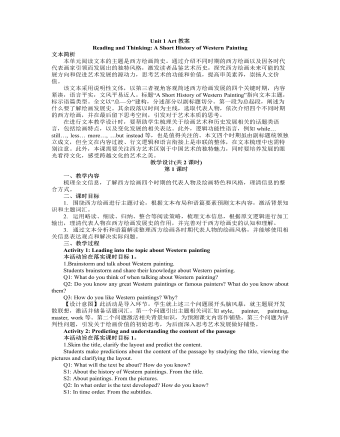
新人教版高中英语选修3Unit 1 Art教案
[2] An important breakthrough…was… [3] Another innovation was … [4] the emphasis increasingly shifted from…to… [5] New ideas and values gradually replaced… [6] While his paintings still had religious themes… … T: All these expressions serve to show how Western painting has developed. Some of them share similar structure but with varied use of words, which makes the text vivid and more readable. 【设计意图】主题类语言整理有助于学生类化语言应用,提高语言输出的丰富性。处理完文本内容信息后,进入语篇信息处理,进行主题相关的词块归类。引导学生快速阅读,寻找表达相同主题(发展或者艺术)的词和短语,再根据词性、用法和结构进行归类,储备主题相关词汇,丰富语言储备,提升语言素养。 Assignment: Go online to gather more information about Chinese painting and write a short history of it. 【设计意图】结合所学,迁移运用,根据实际语境,进行模仿性运用。在此过程中,学生尝试借鉴已学的语言、内容、语篇结构和写作手法来建构新文本,实现语篇输出,同时关注中西艺术文化的差别,加深对优秀文化的认同,培养文化意识。
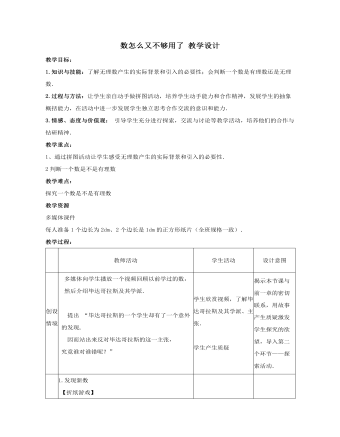
无理数教材教案
1、举例而生活还有类似的例子吗?2、为了加固一个高2米、宽1米的大门,需要在对角线位置加固一条木板,设木板长为a米,a的值可能是整数吗?a的值可能是分数吗?3、2.如下图B,C是一个生活小区的两个路口,BC长为2千米,A处是一个花园,从A到B,C两路口的距离都是2千米,现要从花园到生活小区修一条最短的路,这条路的长可能是整数吗?可能是分数吗?说明理由.4、上图是由16个边长是1的小正方形拼成,任意连接小正方形的若干个顶点,得到一些线段.试分别找出长度是有理数的线段和长度不是有理数的线段.你还能找到其他长度不是有理数的线段吗?
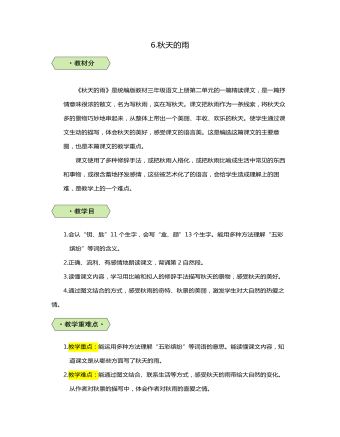
秋天的雨教案
《秋天的雨》是统编版教材三年级语文上册第二单元的一篇精读课文,是一篇抒情意味很浓的散文,名为写秋雨,实在写秋天。课文把秋雨作为一条线索,将秋天众多的景物巧妙地串起来,从整体上带出一个美丽、丰收、欢乐的秋天。使学生通过课文生动的描写,体会秋天的美好,感受课文的语言美。这是编选这篇课文的主要意图,也是本篇课文的教学重点。课文使用了多种修辞手法,或把秋雨人格化,或把秋雨比喻成生活中常见的东西和事物,或很含蓄地抒发感情,这些被艺术化了的语言,会给学生造成理解上的困难,是教学上的一个难点。

正数和负数教案
1、根据3、-3、3。5、-4。5、-5。2、8。5、4。0、-1。2引出正数和负数的定义及特征性质。① 像3、3。5这样大于0的数叫做正数;② 像-3、-4。5这样在正数前面加上符号“-”的数叫做负数。③ 根据需要,有时在正数前面加“+”号,例如+3、+2、+0。5……,就是3、2、0。5……。④ 一个数前面的“+”和“-”号叫做它的符号。⑤ 注意:0既不是正数,也不是负数.2、通过课堂练习1和课堂练习2引出相反意义的量的定义、《活学巧计》诗及做类似题时的方法总结。① 在生活中存在各种各样的量,其中有一种量,它们的属性相同(即同类量),但表示的意义却相反,我们把这样的量叫做相反意义的量.② 活学巧记 相反意义量成对,还要数量和单位, 你为正来我为负,正负兄弟齐上阵。
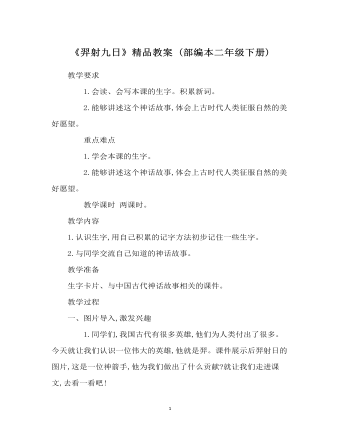
《羿射九日》教案
教学方法 1.自主、合作、探究的学习方法。在识记生字的时候,教师可以让同小组的同学做“找朋友”这个游戏,这样既提高了学生参与的兴趣,又能帮助他们很好地识记生字,一举两得。 2.初读课文,感知文本。让学生带着问题读课文,这样他们会一边读课文,一边思考。学习了生字后,教师可以要求学生用自由读、指名读、开火车读等方式,强化对生字的记忆。 能够讲述羿射九日的神话故事,体会上古时代人类征服自然的美好愿望。 教学过程 一、巩固生字 上节课,我们对羿射九日的故事有了大致的了解,并且分析了羿射日的原因,还学习了生字的认读,下面我们来检查一下我们的学习结果。 1.检查会认字、会写字读音。 (1)认读词(做“找朋友”的游戏) (2)开火车读,指名读。 2.指名学生回答羿射日的原因,经过和结果。 二、理解课文,朗读体会 1.默读课文,用自己的话大致向别人讲述一下《羿射九日》的故事。
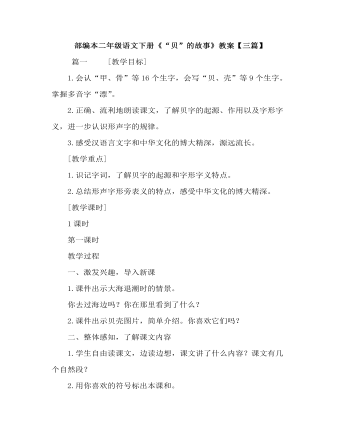
《“贝”的故事》教案
教学目标: 1、会认“甲、骨、类”等16个生字,会写“贴、街、扫”等9个生字,会写“贝壳、甲骨文、样子、可以、钱币、钱财、有关”等词语, 2、默读课文,了解贝字的起源,贝的作用以及字形字义。 一、激趣引入。 1、观察,说说你的发现。 (1)流、泪、河、江(2)说、话、记、读 (3)树、杨、李、林(4)购、货、赠、赚 2、说说你的发现。 生1:第一组的字都是“氵”,三点水的字都与水有关。 生2:第二组的字都是“讠”,言字旁的字都与说话有关。 生3:第三组的字都是“木”,木字旁的字都与树木有关。 生4:第四组的字都是“贝”,贝字旁的字都与钱有关。 3、师:孩子们真聪明,观察得非常仔细。今天,我们就要学习一篇与贝有关的课文。 4、揭示课题:3、贝的故事。
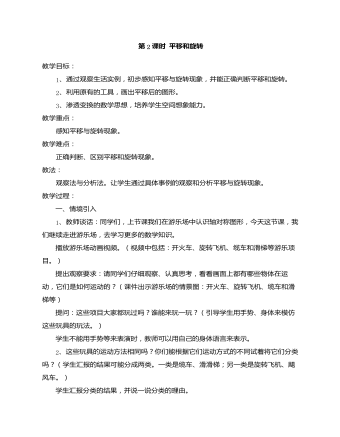
《平移和旋转》教案
1、生活中的平移。谈话:平移和旋转都是物体或图形的位置变化。平移就是物体沿直线移动。像缆车是向前平移,滑滑梯是向斜方向平移,你瞧,这里有一个观光电梯,它是什么运动?(平移) 师:说得真棒,瞧,我们学校的观光电梯,它的上升、下降,都是沿着一条直线移动,就是平移。只要是物体或图形沿着直线移动,就是平移。谈话:我们的生活中有很多这样的平移现象,(教师走到窗户旁)你瞧,老师把窗户打开,这个推开窗户的运动是什么现象?(平移)对了,这是平移,那么在生活中你还见过哪些平移现象吗?举例说说。让学生先说给同组的同学听,再指名回答。师:你们想亲身体验一下平移吗?(想)全体起立,我们一起来,向左平移2步,向右平移2步。真棒!请坐。我们生活中的平移现象可多了,你能用你桌面上的物体做做平移运动吗?(学生边说边做。)
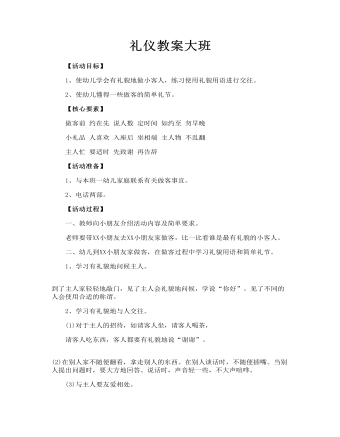
礼仪教案大班
【活动准备】 1、与本班一幼儿家庭联系有关做客事宜。 2、电话两部。 【活动过程】 一、教师向小朋友介绍活动内容及简单要求。 老师要带XX小朋友去XX小朋友家做客,比一比看谁是最有礼貌的小客人。 二、幼儿到XX小朋友家做客,在做客过程中学习礼貌用语和简单礼节。 1、学习有礼貌地问候主人。 到了主人家轻轻地敲门,见了主人会礼貌地问候,学说“你好”。见了不同的人会使用合适的称谓。
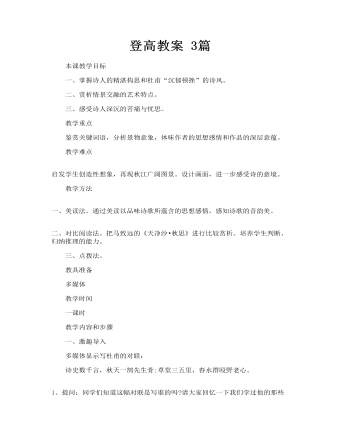
登高教案 3篇
一、激趣导入 多媒体显示写杜甫的对联: 诗史数千言,秋天一鹄先生骨;草堂三五里,春水群殴野老心。 1、提问:同学们知道这幅对联是写谁的吗?请大家回忆一下我们学过他的那些作品?能背诵一首我们共同欣赏吗?(学生背诵)今天我们来学习他的另一首诗歌《登高》(板书)

认识键盘教案
教学目标: 1.知识技能: (1)了解键盘分区。 (2)掌握主键盘区字母键、数字键、符号键的名称和分布规律。 (3)能在“记事本”中输入字符,学会使用几个常用的控制键。 2.过程与方法:学生自主学习与小组合作学习相结合,掌握本课时的教学目标 3.情感态度价值观:培养学生对信息技术课的学习兴趣爱和保持乐观的生活态度。
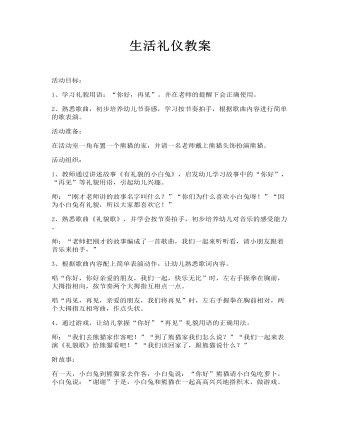
生活礼仪教案
1、教师通过讲述故事《有礼貌的小白兔》,启发幼儿学习故事中的“你好”,“再见”等礼貌用语,引起幼儿兴趣。师:“刚才老师讲的故事名字叫什么?”“你们为什么喜欢小白兔呀!”“因为小白兔有礼貌,所以大家都喜欢它!”2、熟悉歌曲《礼貌歌》,并学会按节奏拍手,初步培养幼儿对音乐的感受能力。师:“老师把刚才的故事编成了一首歌曲,我们一起来听听看,请小朋友跟着音乐来拍手,”
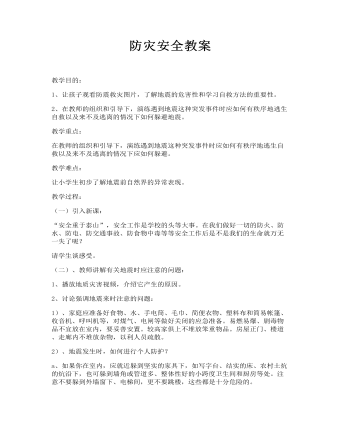
防灾安全教案
教学重点:在教师的组织和引导下,演练遇到地震这种突发事件时应如何有秩序地逃生自救以及来不及逃离的情况下应如何躲避。教学难点:让小学生初步了解地震前自然界的异常表现。教学过程:(一)引入新课:“安全重于泰山”,安全工作是学校的头等大事。在我们做好一切的防火、防水、防电、防交通事故、防食物中毒等等安全工作后是不是我们的生命就万无一失了呢?
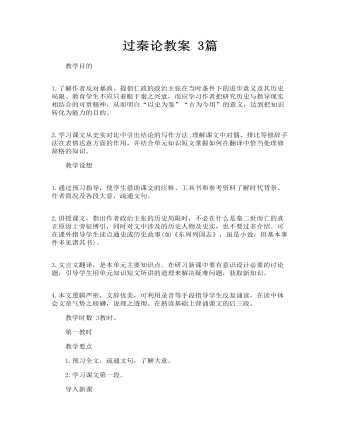
过秦论教案 3篇
1.通过预习指导,使学生借助课文的注释、工具书和参考资料了解时代背景、作者简况及各段大意,疏通文句。 2.讲授课文,指出作者政治主张的历史局限时,不必在什么是秦二世而亡的真正原因上旁征博引,同时对文中涉及的历史人物及史实,也不要过多介绍。可在课外指导学生读点通史或历史故事(如《东周列国志》,虽是小说,但基本事件多见诸其书)。
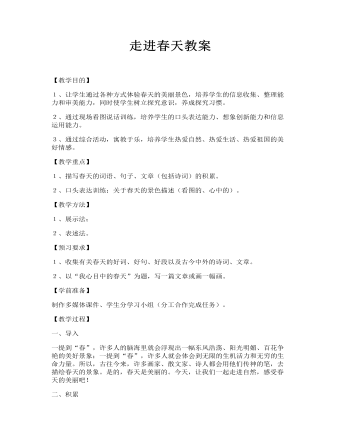
走进春天教案
【教学重点】1、描写春天的词语、句子、文章(包括诗词)的积累。2、口头表达训练:关于春天的景色描述(看图的、心中的)。【教学方法】1、展示法;2、表述法。【预习要求】1、收集有关春天的好词、好句、好段以及古今中外的诗词、文章。2、以“我心目中的春天”为题,写一篇文章或画一幅画。